Marketing Analysis of AirAsia: Strategies for Future Growth
VerifiedAdded on 2023/06/04
|19
|4783
|254
AI Summary
This report provides a comprehensive analysis of AirAsia's internal and external environment, including PESTLE analysis, competitor analysis, and firm analysis. It also suggests marketing strategies for future growth, such as expanding operations on uncovered routes, focusing on service quality improvement, and starting its own repair and maintenance facilities.
Contribute Materials
Your contribution can guide someone’s learning journey. Share your
documents today.
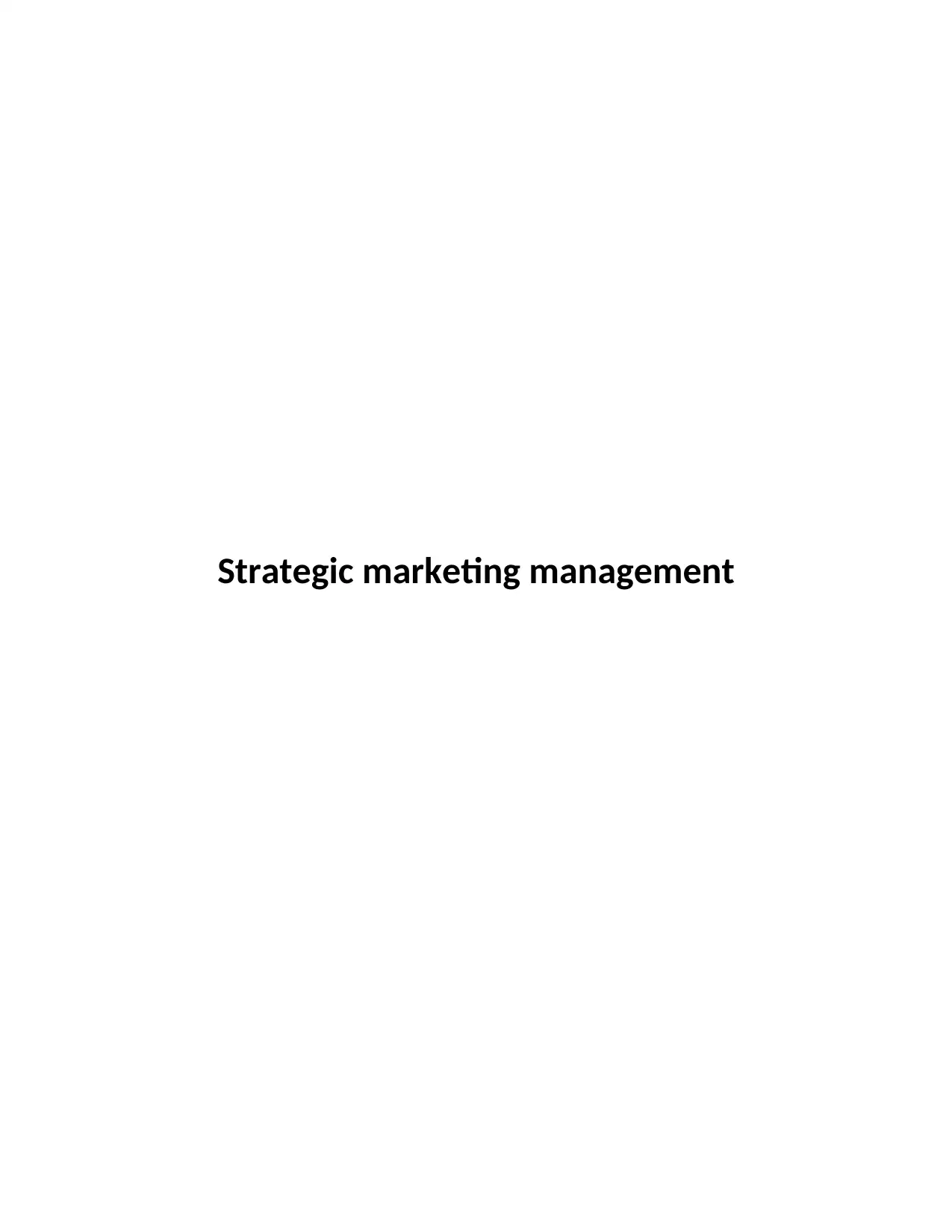
Strategic marketing management
Secure Best Marks with AI Grader
Need help grading? Try our AI Grader for instant feedback on your assignments.
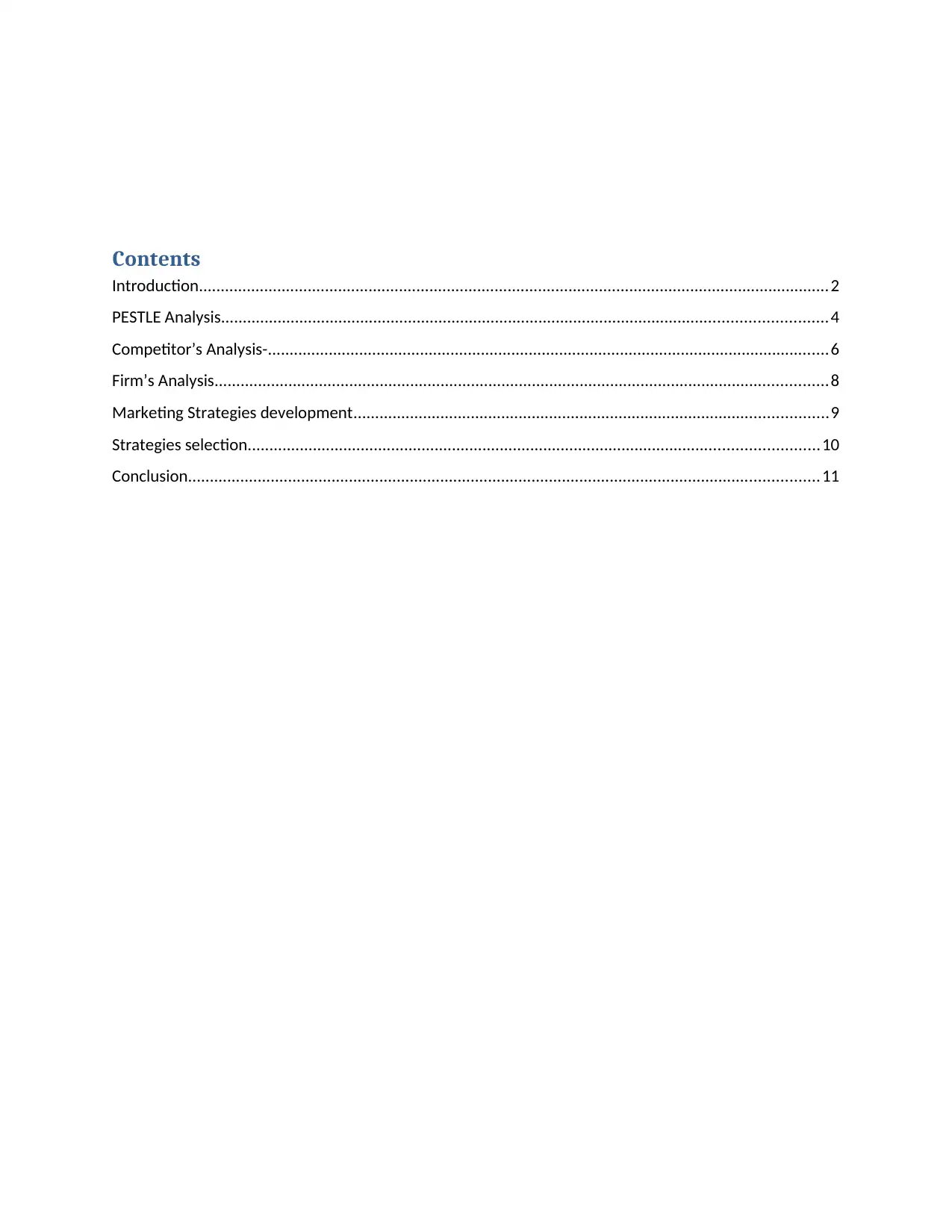
Contents
Introduction.................................................................................................................................................2
PESTLE Analysis...........................................................................................................................................4
Competitor’s Analysis-.................................................................................................................................6
Firm’s Analysis.............................................................................................................................................8
Marketing Strategies development.............................................................................................................9
Strategies selection...................................................................................................................................10
Conclusion.................................................................................................................................................11
Introduction.................................................................................................................................................2
PESTLE Analysis...........................................................................................................................................4
Competitor’s Analysis-.................................................................................................................................6
Firm’s Analysis.............................................................................................................................................8
Marketing Strategies development.............................................................................................................9
Strategies selection...................................................................................................................................10
Conclusion.................................................................................................................................................11
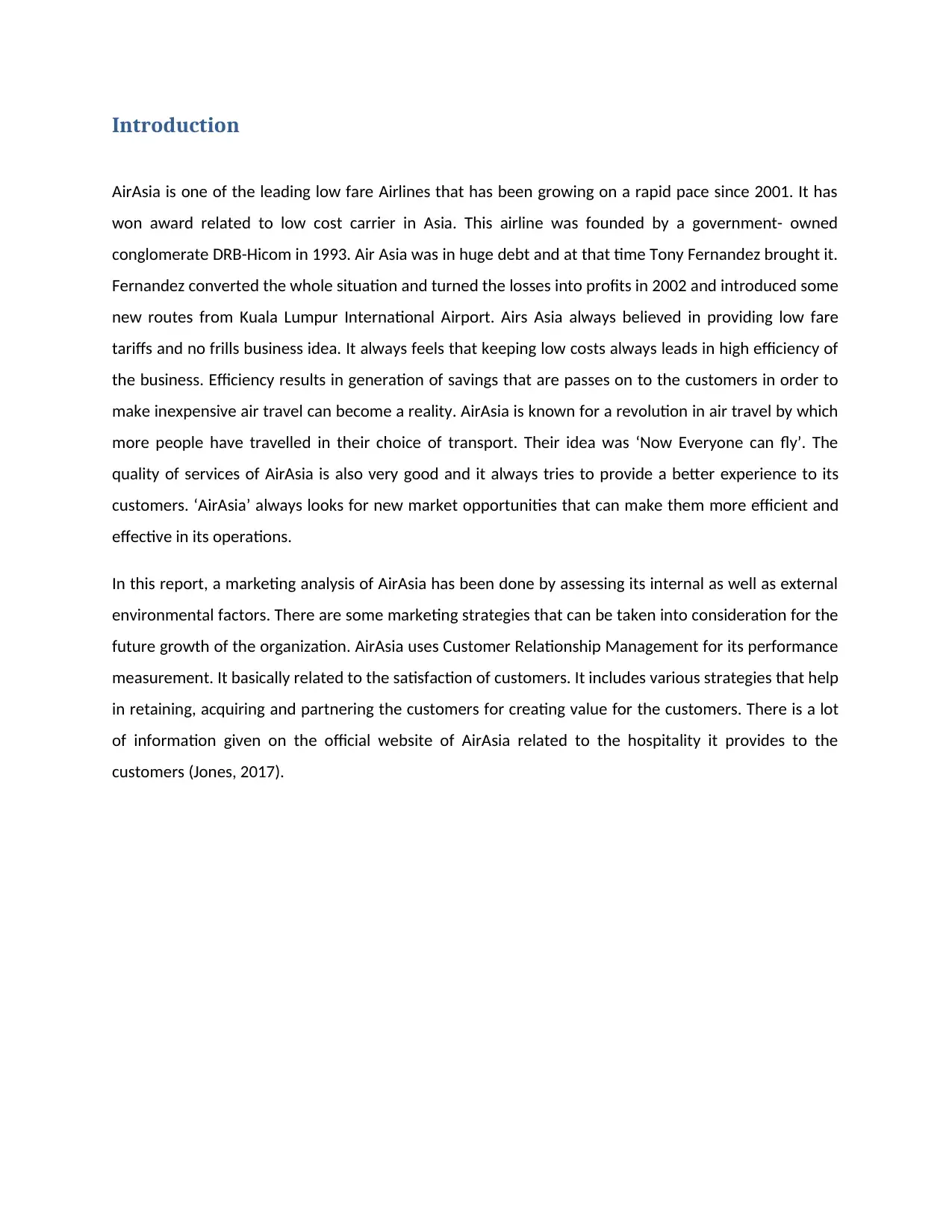
Introduction
AirAsia is one of the leading low fare Airlines that has been growing on a rapid pace since 2001. It has
won award related to low cost carrier in Asia. This airline was founded by a government- owned
conglomerate DRB-Hicom in 1993. Air Asia was in huge debt and at that time Tony Fernandez brought it.
Fernandez converted the whole situation and turned the losses into profits in 2002 and introduced some
new routes from Kuala Lumpur International Airport. Airs Asia always believed in providing low fare
tariffs and no frills business idea. It always feels that keeping low costs always leads in high efficiency of
the business. Efficiency results in generation of savings that are passes on to the customers in order to
make inexpensive air travel can become a reality. AirAsia is known for a revolution in air travel by which
more people have travelled in their choice of transport. Their idea was ‘Now Everyone can fly’. The
quality of services of AirAsia is also very good and it always tries to provide a better experience to its
customers. ‘AirAsia’ always looks for new market opportunities that can make them more efficient and
effective in its operations.
In this report, a marketing analysis of AirAsia has been done by assessing its internal as well as external
environmental factors. There are some marketing strategies that can be taken into consideration for the
future growth of the organization. AirAsia uses Customer Relationship Management for its performance
measurement. It basically related to the satisfaction of customers. It includes various strategies that help
in retaining, acquiring and partnering the customers for creating value for the customers. There is a lot
of information given on the official website of AirAsia related to the hospitality it provides to the
customers (Jones, 2017).
AirAsia is one of the leading low fare Airlines that has been growing on a rapid pace since 2001. It has
won award related to low cost carrier in Asia. This airline was founded by a government- owned
conglomerate DRB-Hicom in 1993. Air Asia was in huge debt and at that time Tony Fernandez brought it.
Fernandez converted the whole situation and turned the losses into profits in 2002 and introduced some
new routes from Kuala Lumpur International Airport. Airs Asia always believed in providing low fare
tariffs and no frills business idea. It always feels that keeping low costs always leads in high efficiency of
the business. Efficiency results in generation of savings that are passes on to the customers in order to
make inexpensive air travel can become a reality. AirAsia is known for a revolution in air travel by which
more people have travelled in their choice of transport. Their idea was ‘Now Everyone can fly’. The
quality of services of AirAsia is also very good and it always tries to provide a better experience to its
customers. ‘AirAsia’ always looks for new market opportunities that can make them more efficient and
effective in its operations.
In this report, a marketing analysis of AirAsia has been done by assessing its internal as well as external
environmental factors. There are some marketing strategies that can be taken into consideration for the
future growth of the organization. AirAsia uses Customer Relationship Management for its performance
measurement. It basically related to the satisfaction of customers. It includes various strategies that help
in retaining, acquiring and partnering the customers for creating value for the customers. There is a lot
of information given on the official website of AirAsia related to the hospitality it provides to the
customers (Jones, 2017).
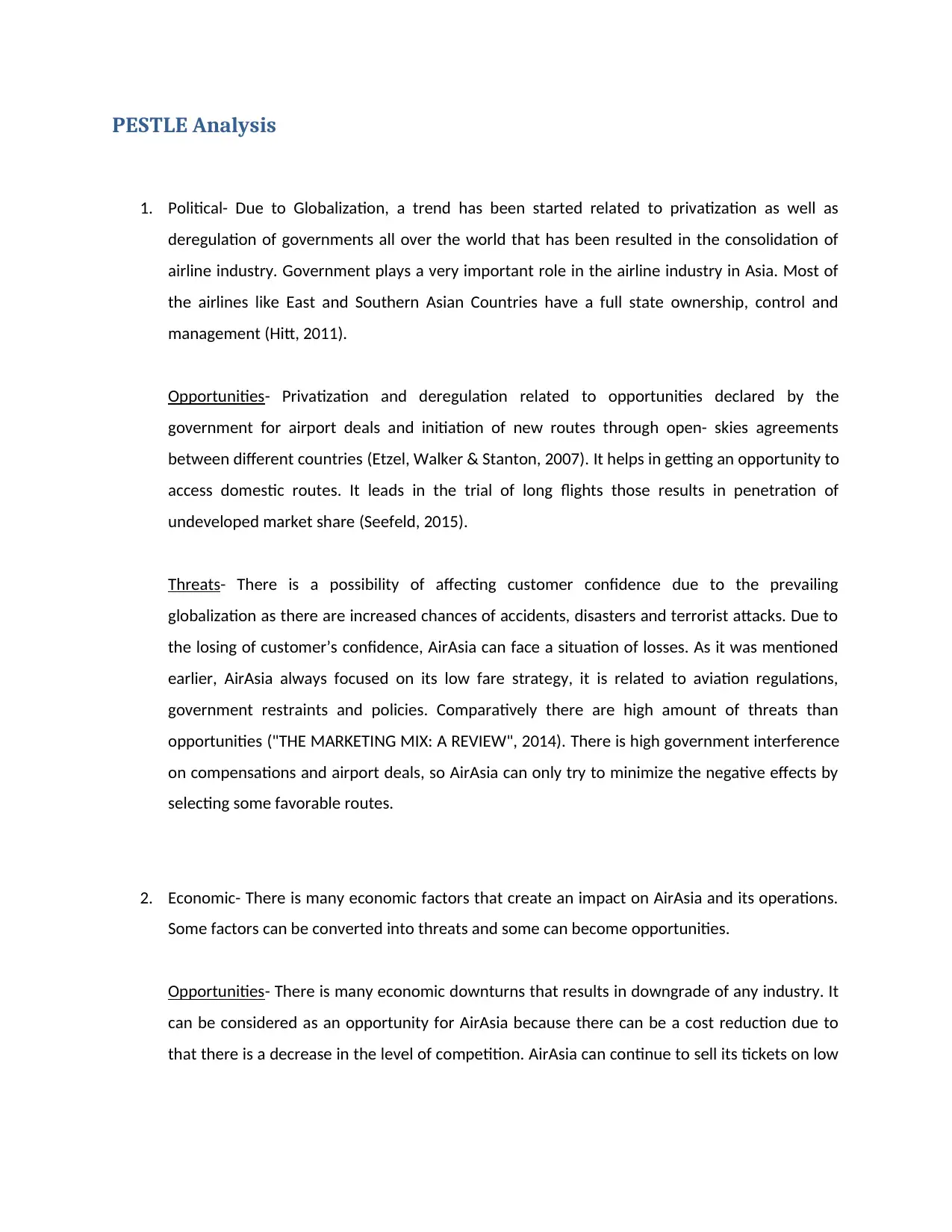
PESTLE Analysis
1. Political- Due to Globalization, a trend has been started related to privatization as well as
deregulation of governments all over the world that has been resulted in the consolidation of
airline industry. Government plays a very important role in the airline industry in Asia. Most of
the airlines like East and Southern Asian Countries have a full state ownership, control and
management (Hitt, 2011).
Opportunities- Privatization and deregulation related to opportunities declared by the
government for airport deals and initiation of new routes through open- skies agreements
between different countries (Etzel, Walker & Stanton, 2007). It helps in getting an opportunity to
access domestic routes. It leads in the trial of long flights those results in penetration of
undeveloped market share (Seefeld, 2015).
Threats- There is a possibility of affecting customer confidence due to the prevailing
globalization as there are increased chances of accidents, disasters and terrorist attacks. Due to
the losing of customer’s confidence, AirAsia can face a situation of losses. As it was mentioned
earlier, AirAsia always focused on its low fare strategy, it is related to aviation regulations,
government restraints and policies. Comparatively there are high amount of threats than
opportunities ("THE MARKETING MIX: A REVIEW", 2014). There is high government interference
on compensations and airport deals, so AirAsia can only try to minimize the negative effects by
selecting some favorable routes.
2. Economic- There is many economic factors that create an impact on AirAsia and its operations.
Some factors can be converted into threats and some can become opportunities.
Opportunities- There is many economic downturns that results in downgrade of any industry. It
can be considered as an opportunity for AirAsia because there can be a cost reduction due to
that there is a decrease in the level of competition. AirAsia can continue to sell its tickets on low
1. Political- Due to Globalization, a trend has been started related to privatization as well as
deregulation of governments all over the world that has been resulted in the consolidation of
airline industry. Government plays a very important role in the airline industry in Asia. Most of
the airlines like East and Southern Asian Countries have a full state ownership, control and
management (Hitt, 2011).
Opportunities- Privatization and deregulation related to opportunities declared by the
government for airport deals and initiation of new routes through open- skies agreements
between different countries (Etzel, Walker & Stanton, 2007). It helps in getting an opportunity to
access domestic routes. It leads in the trial of long flights those results in penetration of
undeveloped market share (Seefeld, 2015).
Threats- There is a possibility of affecting customer confidence due to the prevailing
globalization as there are increased chances of accidents, disasters and terrorist attacks. Due to
the losing of customer’s confidence, AirAsia can face a situation of losses. As it was mentioned
earlier, AirAsia always focused on its low fare strategy, it is related to aviation regulations,
government restraints and policies. Comparatively there are high amount of threats than
opportunities ("THE MARKETING MIX: A REVIEW", 2014). There is high government interference
on compensations and airport deals, so AirAsia can only try to minimize the negative effects by
selecting some favorable routes.
2. Economic- There is many economic factors that create an impact on AirAsia and its operations.
Some factors can be converted into threats and some can become opportunities.
Opportunities- There is many economic downturns that results in downgrade of any industry. It
can be considered as an opportunity for AirAsia because there can be a cost reduction due to
that there is a decrease in the level of competition. AirAsia can continue to sell its tickets on low
Paraphrase This Document
Need a fresh take? Get an instant paraphrase of this document with our AI Paraphraser

rates in such circumstances (David & David, 2016). Due to current recession, there is a high
impact on aviation industry but people enjoy the cheap tickets.
Threats- There is a variation in the fuel prices that can create an impact in the operation costs
when the prices of fuel become high. In such cases, profitability of AirAsia goes down. These are
the events that are unavoidable and opportunities are higher than the threats so I this scenario,
AirAsia can expand its operations in economic downturns. There are some travelers like
corporate and leisure travelers that are very much budget conscious so demand for low fare
would increase (Ha, Oh & Jo, 2013).
3. Social- some social as well as cultural factors with opportunities and threats are-
Opportunities- There is a high economic growth in the recent years that resulted in increasing
AirAsia’s population. This also leads in increasing trade and tourism within Asia as well as
demand for travel was increased (Vaněk, Mikoláš & Žváková, 2012). People became eager to
spend on travelling instead of food and other services. Low fares usually attract customers and it
makes a high profit for AirAsia. It clearly shows that there are high opportunities with AirAsia to
differentiate from the other strong competitors by creating better services for the customers
and providing low fares. They provide food, drinks and online sales to its travelers that result in
increasing brand awareness in front of the customers (Mamula, 2012). There is an increasing
world’s population that includes educated people that helps in the growth of the industry.
Threats- AirAsia is not very successful in implementation of its differentiation strategy so it leads
in increase in operation cost in order to produce some value- added services. In case of social
and cultural aspects, there are more opportunities in comparison to threats with AirAsia until
and unless in unnecessarily increase its cost related to operations for providing value added
services.
4. Technological- Technological factors for AirAsia are-
Opportunities- AirAsia has grown a lot due to the advanced technological aspects. It was the first
airline that started e- ticketing in Southeast Asia. It helped AirAsia in reducing the cost of
impact on aviation industry but people enjoy the cheap tickets.
Threats- There is a variation in the fuel prices that can create an impact in the operation costs
when the prices of fuel become high. In such cases, profitability of AirAsia goes down. These are
the events that are unavoidable and opportunities are higher than the threats so I this scenario,
AirAsia can expand its operations in economic downturns. There are some travelers like
corporate and leisure travelers that are very much budget conscious so demand for low fare
would increase (Ha, Oh & Jo, 2013).
3. Social- some social as well as cultural factors with opportunities and threats are-
Opportunities- There is a high economic growth in the recent years that resulted in increasing
AirAsia’s population. This also leads in increasing trade and tourism within Asia as well as
demand for travel was increased (Vaněk, Mikoláš & Žváková, 2012). People became eager to
spend on travelling instead of food and other services. Low fares usually attract customers and it
makes a high profit for AirAsia. It clearly shows that there are high opportunities with AirAsia to
differentiate from the other strong competitors by creating better services for the customers
and providing low fares. They provide food, drinks and online sales to its travelers that result in
increasing brand awareness in front of the customers (Mamula, 2012). There is an increasing
world’s population that includes educated people that helps in the growth of the industry.
Threats- AirAsia is not very successful in implementation of its differentiation strategy so it leads
in increase in operation cost in order to produce some value- added services. In case of social
and cultural aspects, there are more opportunities in comparison to threats with AirAsia until
and unless in unnecessarily increase its cost related to operations for providing value added
services.
4. Technological- Technological factors for AirAsia are-
Opportunities- AirAsia has grown a lot due to the advanced technological aspects. It was the first
airline that started e- ticketing in Southeast Asia. It helped AirAsia in reducing the cost of
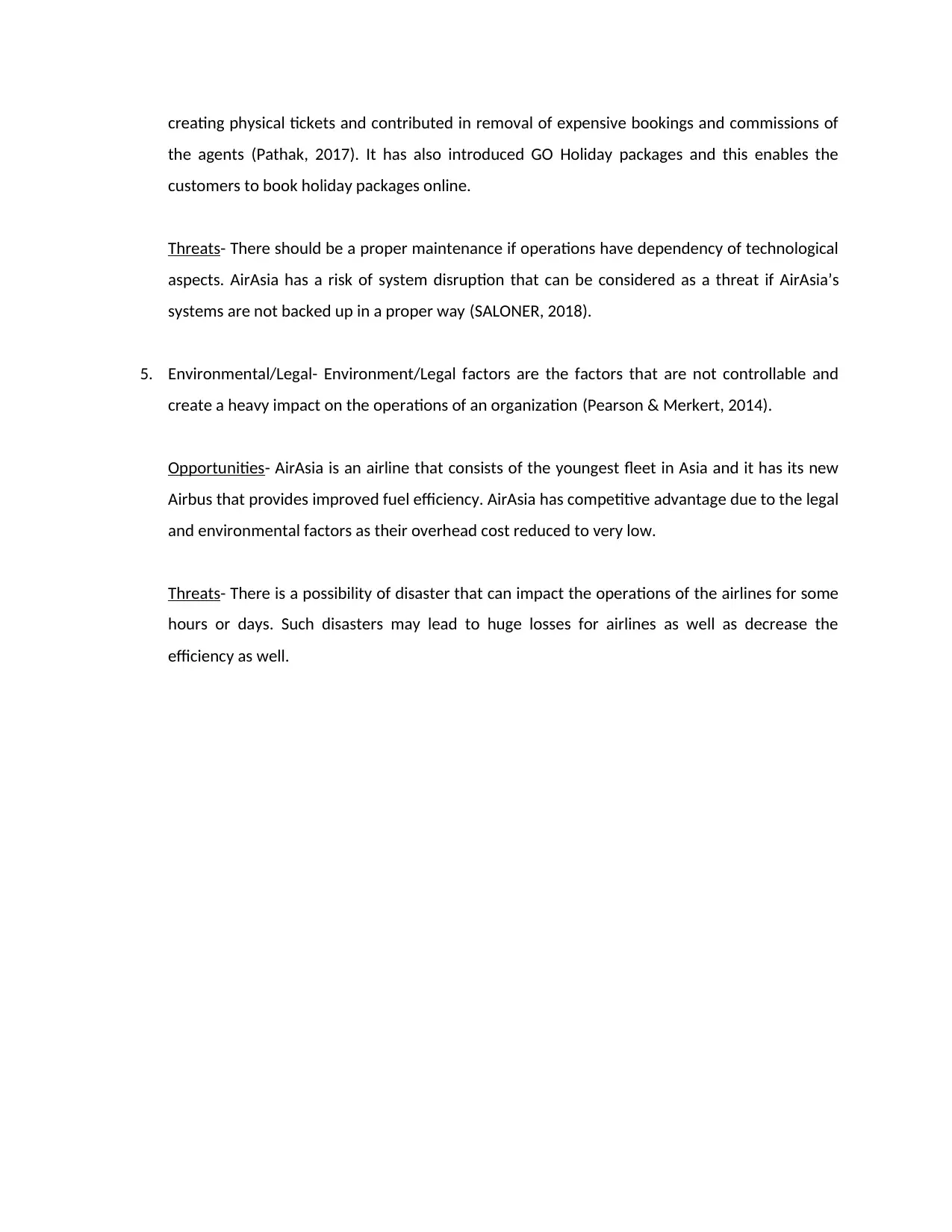
creating physical tickets and contributed in removal of expensive bookings and commissions of
the agents (Pathak, 2017). It has also introduced GO Holiday packages and this enables the
customers to book holiday packages online.
Threats- There should be a proper maintenance if operations have dependency of technological
aspects. AirAsia has a risk of system disruption that can be considered as a threat if AirAsia’s
systems are not backed up in a proper way (SALONER, 2018).
5. Environmental/Legal- Environment/Legal factors are the factors that are not controllable and
create a heavy impact on the operations of an organization (Pearson & Merkert, 2014).
Opportunities- AirAsia is an airline that consists of the youngest fleet in Asia and it has its new
Airbus that provides improved fuel efficiency. AirAsia has competitive advantage due to the legal
and environmental factors as their overhead cost reduced to very low.
Threats- There is a possibility of disaster that can impact the operations of the airlines for some
hours or days. Such disasters may lead to huge losses for airlines as well as decrease the
efficiency as well.
the agents (Pathak, 2017). It has also introduced GO Holiday packages and this enables the
customers to book holiday packages online.
Threats- There should be a proper maintenance if operations have dependency of technological
aspects. AirAsia has a risk of system disruption that can be considered as a threat if AirAsia’s
systems are not backed up in a proper way (SALONER, 2018).
5. Environmental/Legal- Environment/Legal factors are the factors that are not controllable and
create a heavy impact on the operations of an organization (Pearson & Merkert, 2014).
Opportunities- AirAsia is an airline that consists of the youngest fleet in Asia and it has its new
Airbus that provides improved fuel efficiency. AirAsia has competitive advantage due to the legal
and environmental factors as their overhead cost reduced to very low.
Threats- There is a possibility of disaster that can impact the operations of the airlines for some
hours or days. Such disasters may lead to huge losses for airlines as well as decrease the
efficiency as well.
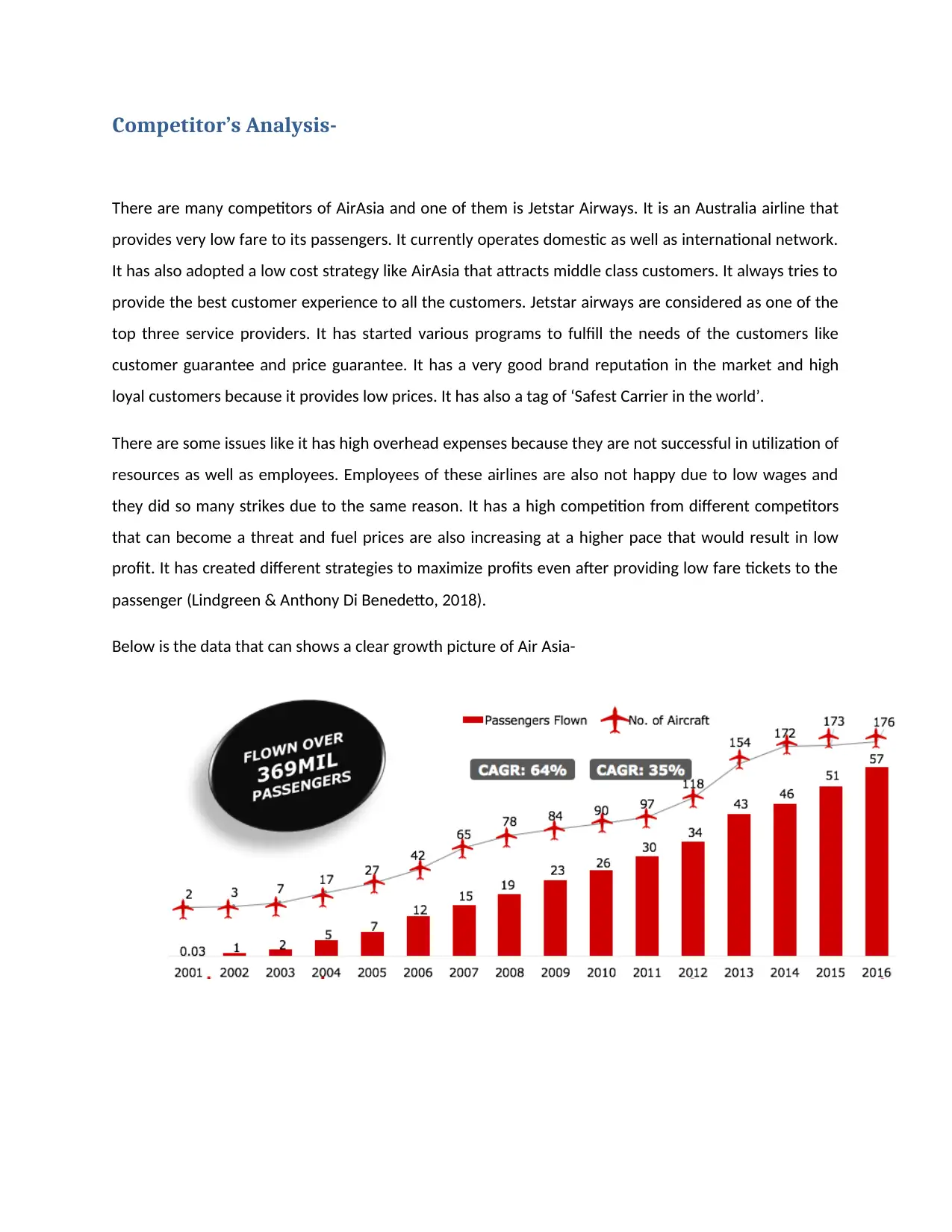
Competitor’s Analysis-
There are many competitors of AirAsia and one of them is Jetstar Airways. It is an Australia airline that
provides very low fare to its passengers. It currently operates domestic as well as international network.
It has also adopted a low cost strategy like AirAsia that attracts middle class customers. It always tries to
provide the best customer experience to all the customers. Jetstar airways are considered as one of the
top three service providers. It has started various programs to fulfill the needs of the customers like
customer guarantee and price guarantee. It has a very good brand reputation in the market and high
loyal customers because it provides low prices. It has also a tag of ‘Safest Carrier in the world’.
There are some issues like it has high overhead expenses because they are not successful in utilization of
resources as well as employees. Employees of these airlines are also not happy due to low wages and
they did so many strikes due to the same reason. It has a high competition from different competitors
that can become a threat and fuel prices are also increasing at a higher pace that would result in low
profit. It has created different strategies to maximize profits even after providing low fare tickets to the
passenger (Lindgreen & Anthony Di Benedetto, 2018).
Below is the data that can shows a clear growth picture of Air Asia-
There are many competitors of AirAsia and one of them is Jetstar Airways. It is an Australia airline that
provides very low fare to its passengers. It currently operates domestic as well as international network.
It has also adopted a low cost strategy like AirAsia that attracts middle class customers. It always tries to
provide the best customer experience to all the customers. Jetstar airways are considered as one of the
top three service providers. It has started various programs to fulfill the needs of the customers like
customer guarantee and price guarantee. It has a very good brand reputation in the market and high
loyal customers because it provides low prices. It has also a tag of ‘Safest Carrier in the world’.
There are some issues like it has high overhead expenses because they are not successful in utilization of
resources as well as employees. Employees of these airlines are also not happy due to low wages and
they did so many strikes due to the same reason. It has a high competition from different competitors
that can become a threat and fuel prices are also increasing at a higher pace that would result in low
profit. It has created different strategies to maximize profits even after providing low fare tickets to the
passenger (Lindgreen & Anthony Di Benedetto, 2018).
Below is the data that can shows a clear growth picture of Air Asia-
Secure Best Marks with AI Grader
Need help grading? Try our AI Grader for instant feedback on your assignments.
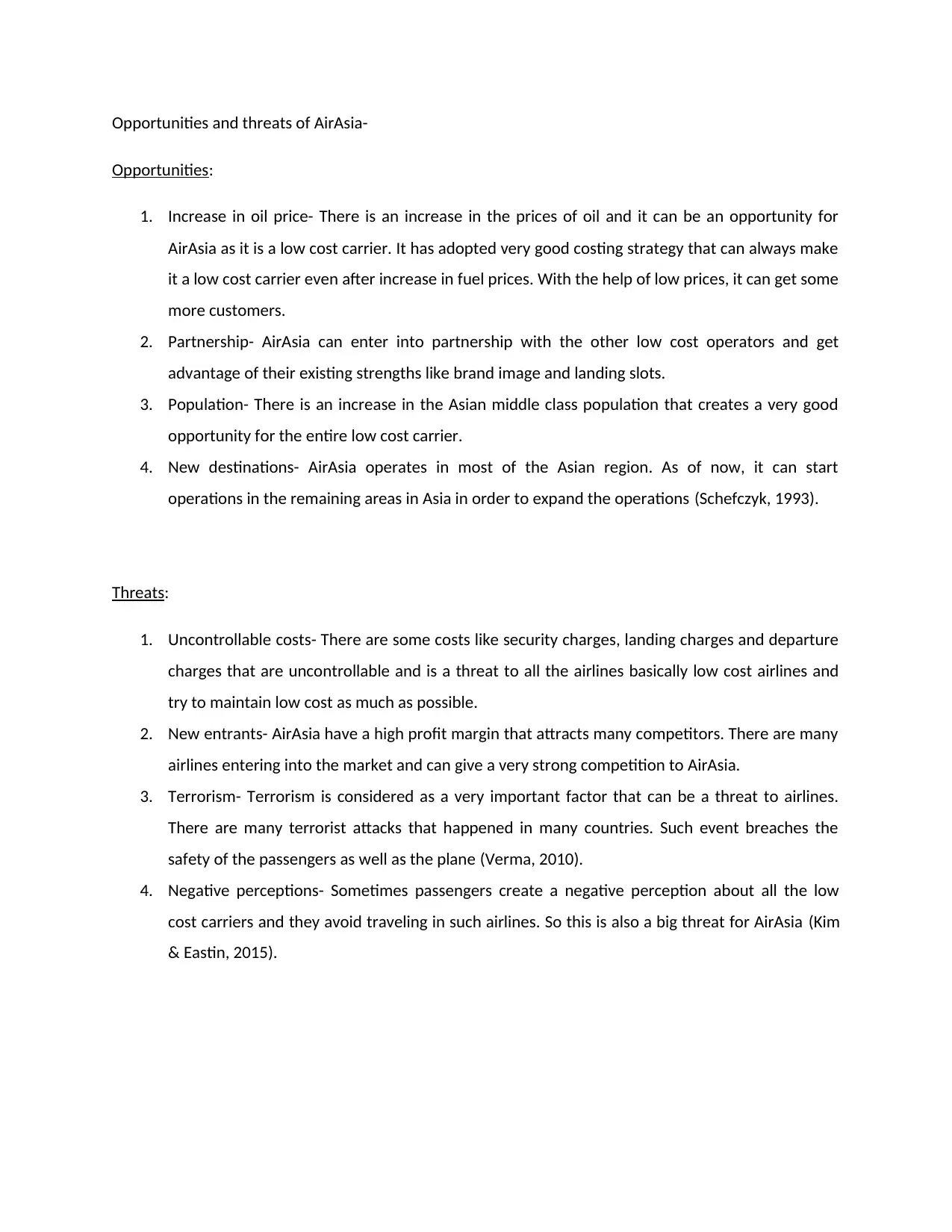
Opportunities and threats of AirAsia-
Opportunities:
1. Increase in oil price- There is an increase in the prices of oil and it can be an opportunity for
AirAsia as it is a low cost carrier. It has adopted very good costing strategy that can always make
it a low cost carrier even after increase in fuel prices. With the help of low prices, it can get some
more customers.
2. Partnership- AirAsia can enter into partnership with the other low cost operators and get
advantage of their existing strengths like brand image and landing slots.
3. Population- There is an increase in the Asian middle class population that creates a very good
opportunity for the entire low cost carrier.
4. New destinations- AirAsia operates in most of the Asian region. As of now, it can start
operations in the remaining areas in Asia in order to expand the operations (Schefczyk, 1993).
Threats:
1. Uncontrollable costs- There are some costs like security charges, landing charges and departure
charges that are uncontrollable and is a threat to all the airlines basically low cost airlines and
try to maintain low cost as much as possible.
2. New entrants- AirAsia have a high profit margin that attracts many competitors. There are many
airlines entering into the market and can give a very strong competition to AirAsia.
3. Terrorism- Terrorism is considered as a very important factor that can be a threat to airlines.
There are many terrorist attacks that happened in many countries. Such event breaches the
safety of the passengers as well as the plane (Verma, 2010).
4. Negative perceptions- Sometimes passengers create a negative perception about all the low
cost carriers and they avoid traveling in such airlines. So this is also a big threat for AirAsia (Kim
& Eastin, 2015).
Opportunities:
1. Increase in oil price- There is an increase in the prices of oil and it can be an opportunity for
AirAsia as it is a low cost carrier. It has adopted very good costing strategy that can always make
it a low cost carrier even after increase in fuel prices. With the help of low prices, it can get some
more customers.
2. Partnership- AirAsia can enter into partnership with the other low cost operators and get
advantage of their existing strengths like brand image and landing slots.
3. Population- There is an increase in the Asian middle class population that creates a very good
opportunity for the entire low cost carrier.
4. New destinations- AirAsia operates in most of the Asian region. As of now, it can start
operations in the remaining areas in Asia in order to expand the operations (Schefczyk, 1993).
Threats:
1. Uncontrollable costs- There are some costs like security charges, landing charges and departure
charges that are uncontrollable and is a threat to all the airlines basically low cost airlines and
try to maintain low cost as much as possible.
2. New entrants- AirAsia have a high profit margin that attracts many competitors. There are many
airlines entering into the market and can give a very strong competition to AirAsia.
3. Terrorism- Terrorism is considered as a very important factor that can be a threat to airlines.
There are many terrorist attacks that happened in many countries. Such event breaches the
safety of the passengers as well as the plane (Verma, 2010).
4. Negative perceptions- Sometimes passengers create a negative perception about all the low
cost carriers and they avoid traveling in such airlines. So this is also a big threat for AirAsia (Kim
& Eastin, 2015).

Firm’s Analysis
Marketing Assets
Customer-based
Assets
Air Asia has a great brand image and it has a perfect target market. As Air Asia is known
for its low cost strategy and there are many middle class people who prefer to pay less
for travelling in flights. Air Asia involved in direct selling and it helps in understanding
the requirement of customers as well as maintaining strong relationship. Its products
and services are quality specific and never compromise.
Internal Support
Assets
AirAsia has a very strong management that helps in the fast growth of the airlines.
There is a strong team that consists of experts from the industry and some of them are
ex- government officials (McGee, Thomas & Wilson, 2006). It has a very strong
workforce with all the required skills.
Supply Chain
Assets
AirAsia is an airline that is involved in the direct sales with the help of its website and
call centre. The main motive behind involvement in direct sales is to avoid middlemen
commission. Direct sales also help in reducing the dependency of airlines on outside
resources. There are many benefits of direct sales as it results in direct interaction with
the customers and understand the expectation and fulfil the same in the best possible
manner. Air Asia has a dependency on the suppliers and they never faced any problem
in acquiring airplane from the suppliers because it is basically an Airbus’s airplane user.
Alliance-based
Assets
There are strong Alliance- based assets of Air Asia as it has good corporate affiliate
relationships with the entities and agencies. It does not have its own maintenance
centres that sometimes create a negative impact. There are many airlines that have a
strong alliance with Air Asia.
Marketing Assets
Customer-based
Assets
Air Asia has a great brand image and it has a perfect target market. As Air Asia is known
for its low cost strategy and there are many middle class people who prefer to pay less
for travelling in flights. Air Asia involved in direct selling and it helps in understanding
the requirement of customers as well as maintaining strong relationship. Its products
and services are quality specific and never compromise.
Internal Support
Assets
AirAsia has a very strong management that helps in the fast growth of the airlines.
There is a strong team that consists of experts from the industry and some of them are
ex- government officials (McGee, Thomas & Wilson, 2006). It has a very strong
workforce with all the required skills.
Supply Chain
Assets
AirAsia is an airline that is involved in the direct sales with the help of its website and
call centre. The main motive behind involvement in direct sales is to avoid middlemen
commission. Direct sales also help in reducing the dependency of airlines on outside
resources. There are many benefits of direct sales as it results in direct interaction with
the customers and understand the expectation and fulfil the same in the best possible
manner. Air Asia has a dependency on the suppliers and they never faced any problem
in acquiring airplane from the suppliers because it is basically an Airbus’s airplane user.
Alliance-based
Assets
There are strong Alliance- based assets of Air Asia as it has good corporate affiliate
relationships with the entities and agencies. It does not have its own maintenance
centres that sometimes create a negative impact. There are many airlines that have a
strong alliance with Air Asia.
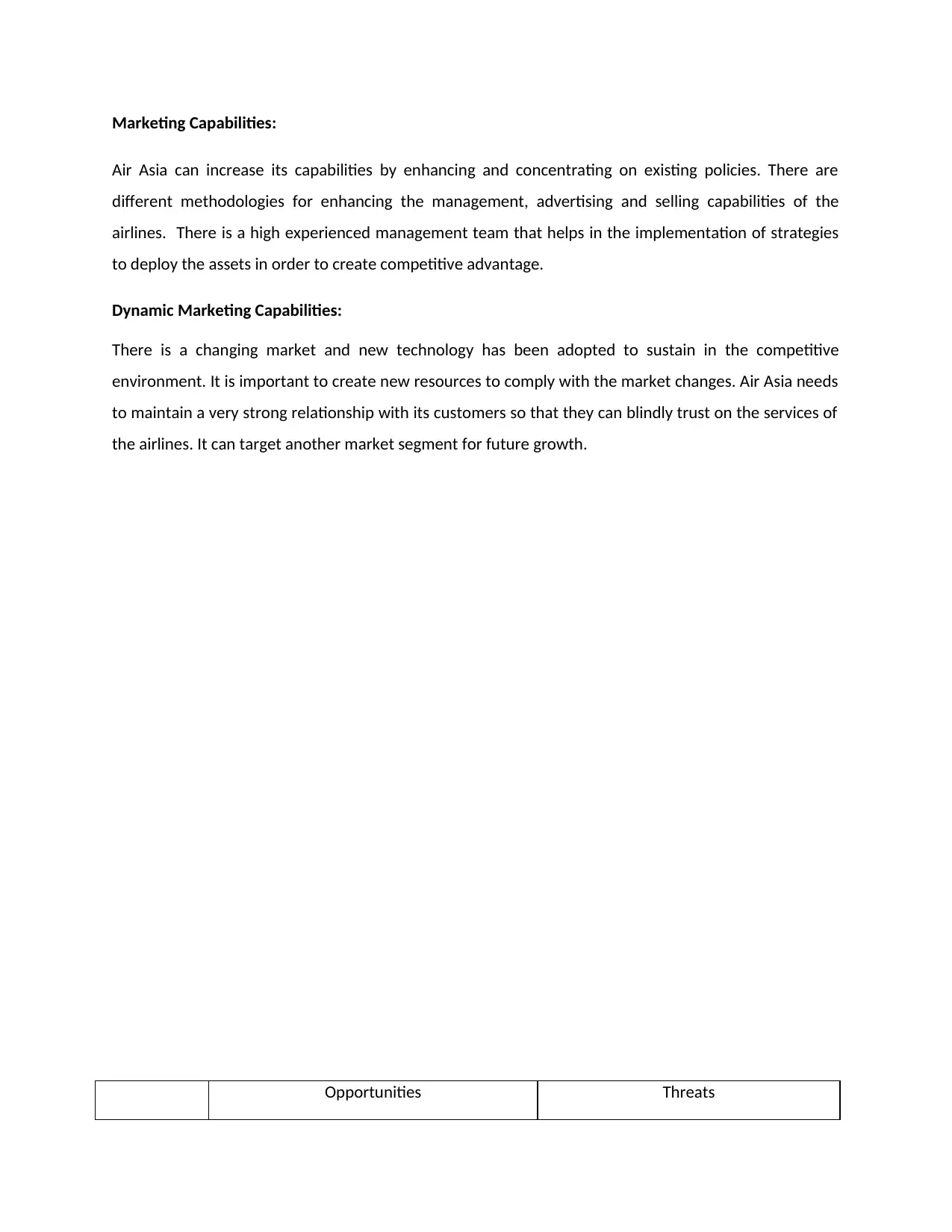
Marketing Capabilities:
Air Asia can increase its capabilities by enhancing and concentrating on existing policies. There are
different methodologies for enhancing the management, advertising and selling capabilities of the
airlines. There is a high experienced management team that helps in the implementation of strategies
to deploy the assets in order to create competitive advantage.
Dynamic Marketing Capabilities:
There is a changing market and new technology has been adopted to sustain in the competitive
environment. It is important to create new resources to comply with the market changes. Air Asia needs
to maintain a very strong relationship with its customers so that they can blindly trust on the services of
the airlines. It can target another market segment for future growth.
Opportunities Threats
Air Asia can increase its capabilities by enhancing and concentrating on existing policies. There are
different methodologies for enhancing the management, advertising and selling capabilities of the
airlines. There is a high experienced management team that helps in the implementation of strategies
to deploy the assets in order to create competitive advantage.
Dynamic Marketing Capabilities:
There is a changing market and new technology has been adopted to sustain in the competitive
environment. It is important to create new resources to comply with the market changes. Air Asia needs
to maintain a very strong relationship with its customers so that they can blindly trust on the services of
the airlines. It can target another market segment for future growth.
Opportunities Threats
Paraphrase This Document
Need a fresh take? Get an instant paraphrase of this document with our AI Paraphraser
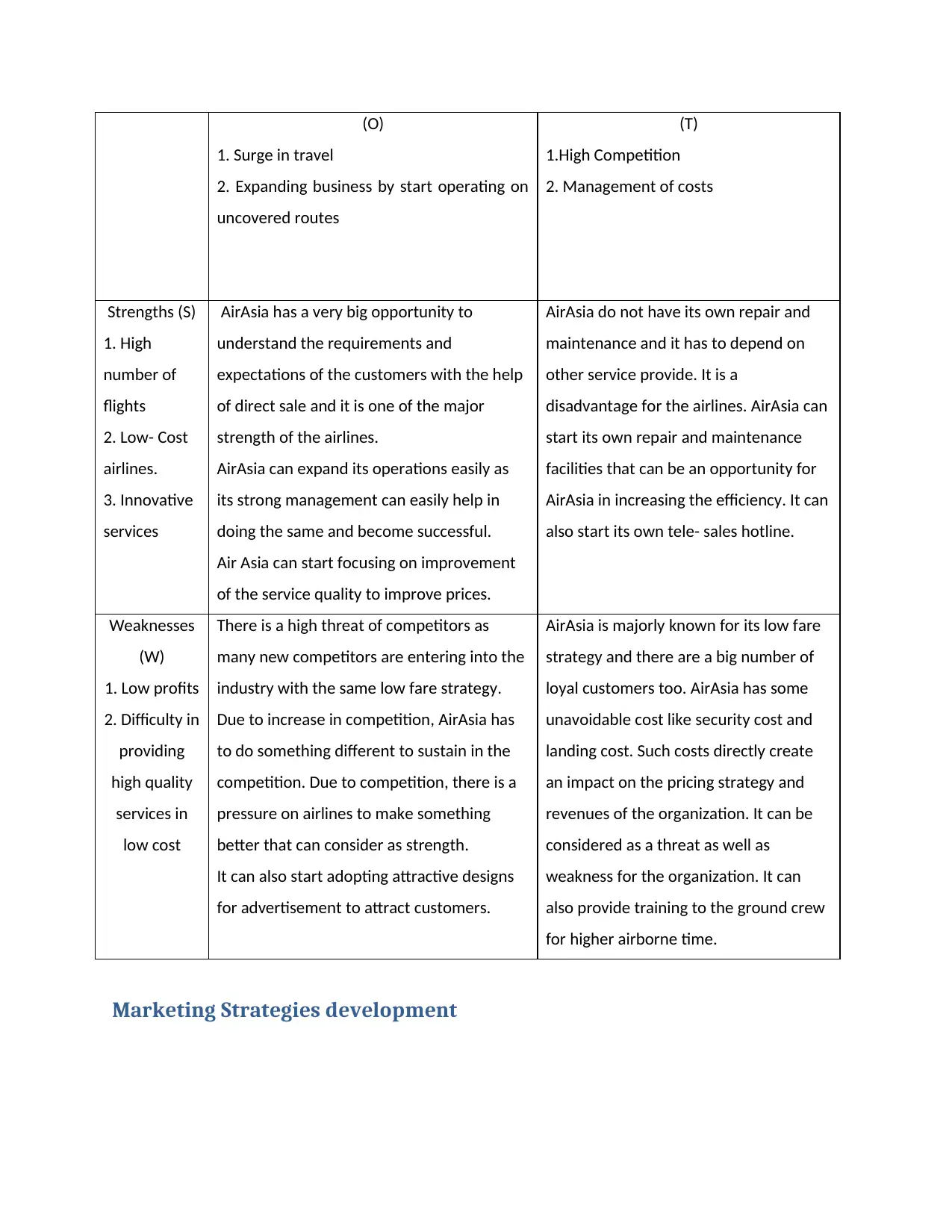
(O)
1. Surge in travel
2. Expanding business by start operating on
uncovered routes
(T)
1.High Competition
2. Management of costs
Strengths (S)
1. High
number of
flights
2. Low- Cost
airlines.
3. Innovative
services
AirAsia has a very big opportunity to
understand the requirements and
expectations of the customers with the help
of direct sale and it is one of the major
strength of the airlines.
AirAsia can expand its operations easily as
its strong management can easily help in
doing the same and become successful.
Air Asia can start focusing on improvement
of the service quality to improve prices.
AirAsia do not have its own repair and
maintenance and it has to depend on
other service provide. It is a
disadvantage for the airlines. AirAsia can
start its own repair and maintenance
facilities that can be an opportunity for
AirAsia in increasing the efficiency. It can
also start its own tele- sales hotline.
Weaknesses
(W)
1. Low profits
2. Difficulty in
providing
high quality
services in
low cost
There is a high threat of competitors as
many new competitors are entering into the
industry with the same low fare strategy.
Due to increase in competition, AirAsia has
to do something different to sustain in the
competition. Due to competition, there is a
pressure on airlines to make something
better that can consider as strength.
It can also start adopting attractive designs
for advertisement to attract customers.
AirAsia is majorly known for its low fare
strategy and there are a big number of
loyal customers too. AirAsia has some
unavoidable cost like security cost and
landing cost. Such costs directly create
an impact on the pricing strategy and
revenues of the organization. It can be
considered as a threat as well as
weakness for the organization. It can
also provide training to the ground crew
for higher airborne time.
Marketing Strategies development
1. Surge in travel
2. Expanding business by start operating on
uncovered routes
(T)
1.High Competition
2. Management of costs
Strengths (S)
1. High
number of
flights
2. Low- Cost
airlines.
3. Innovative
services
AirAsia has a very big opportunity to
understand the requirements and
expectations of the customers with the help
of direct sale and it is one of the major
strength of the airlines.
AirAsia can expand its operations easily as
its strong management can easily help in
doing the same and become successful.
Air Asia can start focusing on improvement
of the service quality to improve prices.
AirAsia do not have its own repair and
maintenance and it has to depend on
other service provide. It is a
disadvantage for the airlines. AirAsia can
start its own repair and maintenance
facilities that can be an opportunity for
AirAsia in increasing the efficiency. It can
also start its own tele- sales hotline.
Weaknesses
(W)
1. Low profits
2. Difficulty in
providing
high quality
services in
low cost
There is a high threat of competitors as
many new competitors are entering into the
industry with the same low fare strategy.
Due to increase in competition, AirAsia has
to do something different to sustain in the
competition. Due to competition, there is a
pressure on airlines to make something
better that can consider as strength.
It can also start adopting attractive designs
for advertisement to attract customers.
AirAsia is majorly known for its low fare
strategy and there are a big number of
loyal customers too. AirAsia has some
unavoidable cost like security cost and
landing cost. Such costs directly create
an impact on the pricing strategy and
revenues of the organization. It can be
considered as a threat as well as
weakness for the organization. It can
also provide training to the ground crew
for higher airborne time.
Marketing Strategies development
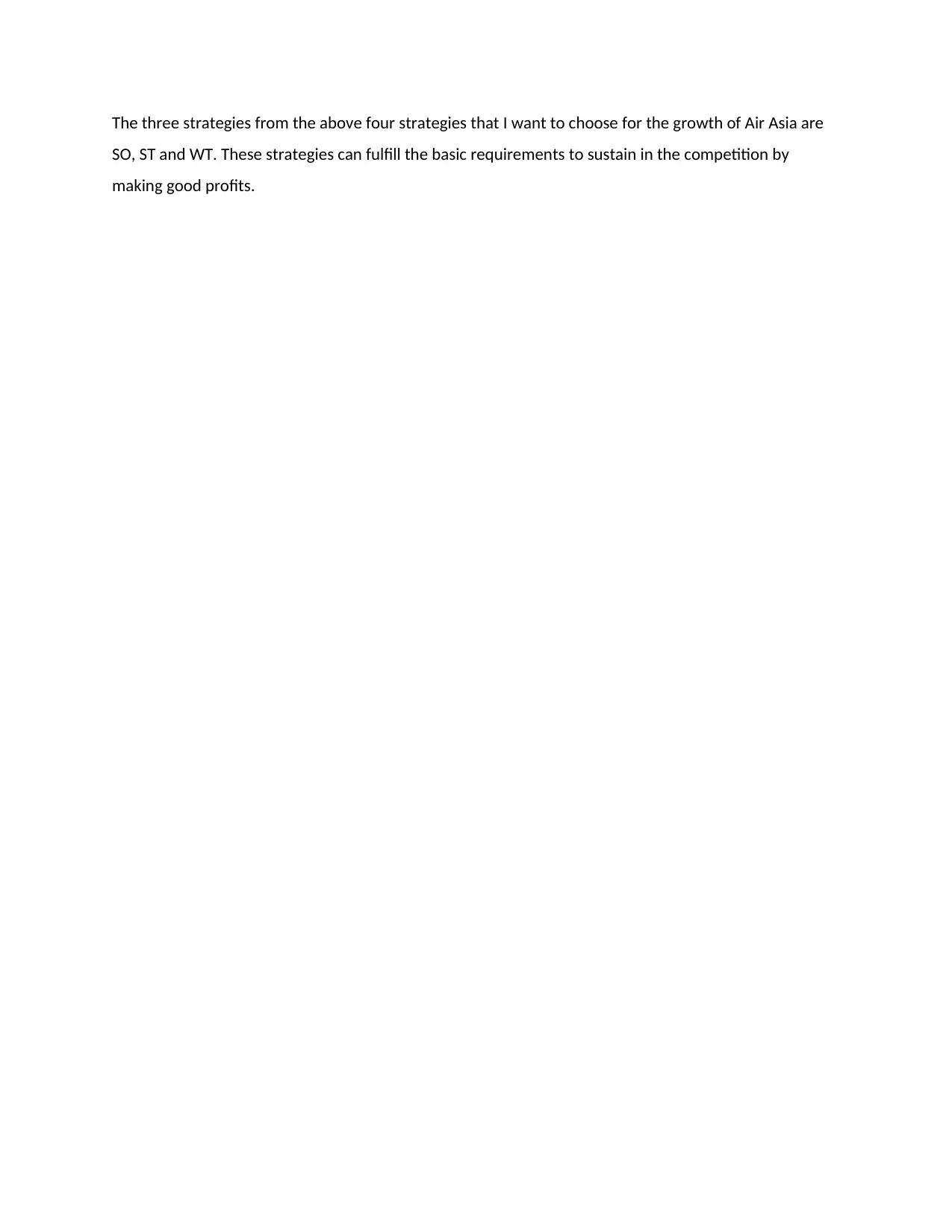
The three strategies from the above four strategies that I want to choose for the growth of Air Asia are
SO, ST and WT. These strategies can fulfill the basic requirements to sustain in the competition by
making good profits.
SO, ST and WT. These strategies can fulfill the basic requirements to sustain in the competition by
making good profits.
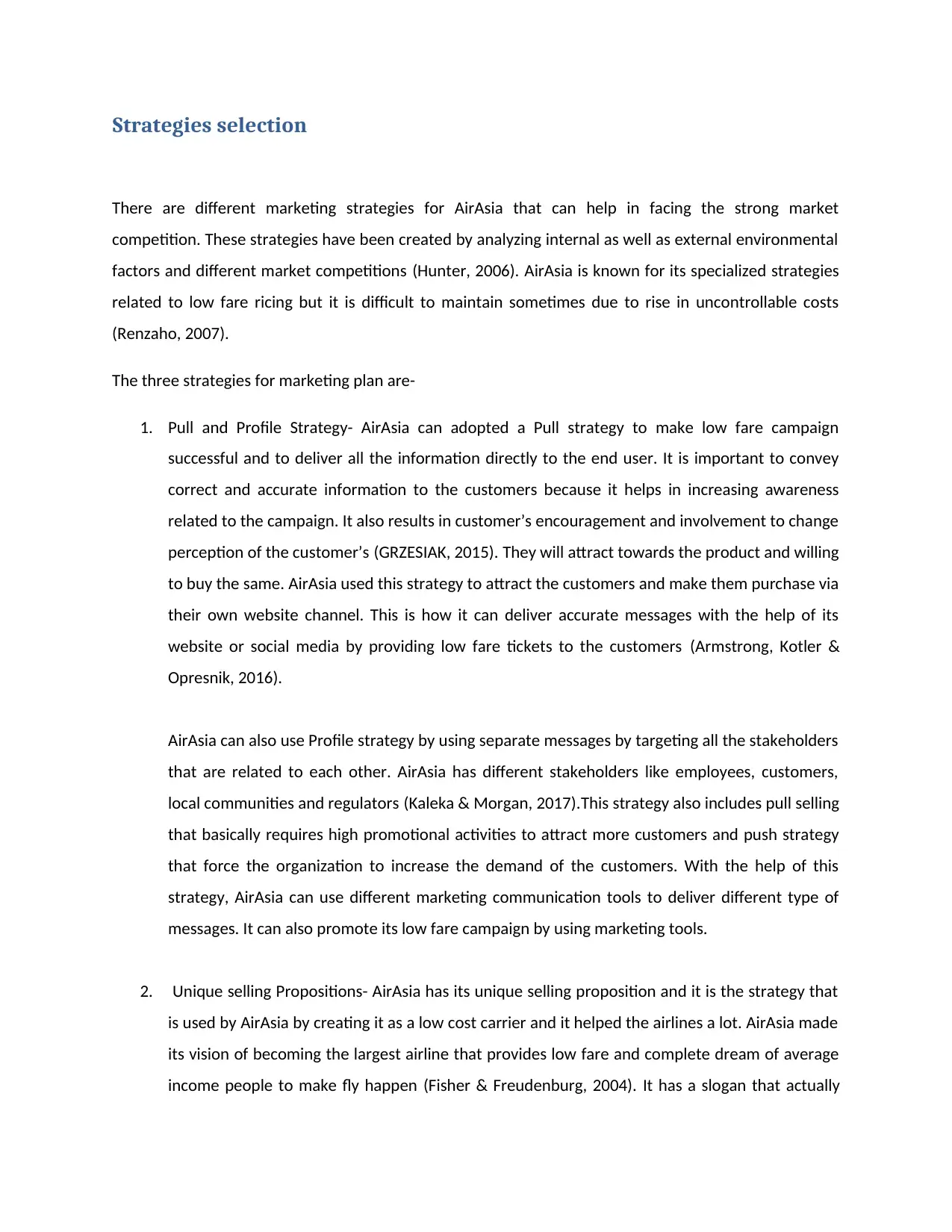
Strategies selection
There are different marketing strategies for AirAsia that can help in facing the strong market
competition. These strategies have been created by analyzing internal as well as external environmental
factors and different market competitions (Hunter, 2006). AirAsia is known for its specialized strategies
related to low fare ricing but it is difficult to maintain sometimes due to rise in uncontrollable costs
(Renzaho, 2007).
The three strategies for marketing plan are-
1. Pull and Profile Strategy- AirAsia can adopted a Pull strategy to make low fare campaign
successful and to deliver all the information directly to the end user. It is important to convey
correct and accurate information to the customers because it helps in increasing awareness
related to the campaign. It also results in customer’s encouragement and involvement to change
perception of the customer’s (GRZESIAK, 2015). They will attract towards the product and willing
to buy the same. AirAsia used this strategy to attract the customers and make them purchase via
their own website channel. This is how it can deliver accurate messages with the help of its
website or social media by providing low fare tickets to the customers (Armstrong, Kotler &
Opresnik, 2016).
AirAsia can also use Profile strategy by using separate messages by targeting all the stakeholders
that are related to each other. AirAsia has different stakeholders like employees, customers,
local communities and regulators (Kaleka & Morgan, 2017).This strategy also includes pull selling
that basically requires high promotional activities to attract more customers and push strategy
that force the organization to increase the demand of the customers. With the help of this
strategy, AirAsia can use different marketing communication tools to deliver different type of
messages. It can also promote its low fare campaign by using marketing tools.
2. Unique selling Propositions- AirAsia has its unique selling proposition and it is the strategy that
is used by AirAsia by creating it as a low cost carrier and it helped the airlines a lot. AirAsia made
its vision of becoming the largest airline that provides low fare and complete dream of average
income people to make fly happen (Fisher & Freudenburg, 2004). It has a slogan that actually
There are different marketing strategies for AirAsia that can help in facing the strong market
competition. These strategies have been created by analyzing internal as well as external environmental
factors and different market competitions (Hunter, 2006). AirAsia is known for its specialized strategies
related to low fare ricing but it is difficult to maintain sometimes due to rise in uncontrollable costs
(Renzaho, 2007).
The three strategies for marketing plan are-
1. Pull and Profile Strategy- AirAsia can adopted a Pull strategy to make low fare campaign
successful and to deliver all the information directly to the end user. It is important to convey
correct and accurate information to the customers because it helps in increasing awareness
related to the campaign. It also results in customer’s encouragement and involvement to change
perception of the customer’s (GRZESIAK, 2015). They will attract towards the product and willing
to buy the same. AirAsia used this strategy to attract the customers and make them purchase via
their own website channel. This is how it can deliver accurate messages with the help of its
website or social media by providing low fare tickets to the customers (Armstrong, Kotler &
Opresnik, 2016).
AirAsia can also use Profile strategy by using separate messages by targeting all the stakeholders
that are related to each other. AirAsia has different stakeholders like employees, customers,
local communities and regulators (Kaleka & Morgan, 2017).This strategy also includes pull selling
that basically requires high promotional activities to attract more customers and push strategy
that force the organization to increase the demand of the customers. With the help of this
strategy, AirAsia can use different marketing communication tools to deliver different type of
messages. It can also promote its low fare campaign by using marketing tools.
2. Unique selling Propositions- AirAsia has its unique selling proposition and it is the strategy that
is used by AirAsia by creating it as a low cost carrier and it helped the airlines a lot. AirAsia made
its vision of becoming the largest airline that provides low fare and complete dream of average
income people to make fly happen (Fisher & Freudenburg, 2004). It has a slogan that actually
Secure Best Marks with AI Grader
Need help grading? Try our AI Grader for instant feedback on your assignments.

means a lot “Now everyone can fly” and it means low fare tactics that can enables customers to
travel in flights. AirAsia can use different strategies that can help in making its low fare strategy
successful. Various strategies were adopted by AirAsia for the maintenance of their airplanes.
First strategy was Safety First Strategy in which the organization replicates the other airline
operations safety strategy and entering into partnership with the world’s recognized repairing
and maintenance manufacturer. The second strategy is increasing productivity in which AirAsia
applies High Aircraft Utilization to make sure that the cost is comparatively lower and at the
same time productivity is high. The third strategy is simplicity, by which AirAsia is able to
maintain low fare and maintain quality. The fourth and last strategy is diversification of
distribution channels, thus, enabling customer to have real time information with a high degree
of flexibility regarding booking information and the flight schedule information (Campling,
2008).
3. Diversification – AirAsia had developed activities in such a manner by which there is a high
degree of diversification, and as a result, increasing effectiveness and efficiency. The first is
Horizontal Diversification in which the company developed activities which are complimentary
to company’s present activities. AirAsia has partnered with Awair, which is an Indonesian Airline.
It enabled AirAsia to understand the conditions of local market of Indonesia, thus ensuring its
growth and survival there. The second is Vertical diversification, i.e. directly undertaking its
tickets selling activities without the intervention of an intermediary, through its own website
and call center. The third is Conglomeration, in which AirAsia is having a back-up in case the
airline industry falls down, thus enabling it to be above the water. But, for implementing the
same AirAsia would be requiring a strong management as well as financial ability to make the
business successful. If the strategy got failed then it can create some bad circumstances that
lead to loss of money and resources.
In all the three strategies, according to me pull and profile strategy will be most suitable for Air Asia
because customer satisfaction matters a lot for an organization. Sometimes organization is unable to
understand the needs and requirements of the customers and they become failed to provide the
required services to them (David & David, 2016). Air Asia is involved in direct sales so it can easily
interact with the customers with its own official website and can know the feedbacks and reviews of the
same. Pull and profile strategy can help the airlines to successfully convey their messages to the
customers without any filter. It can help the customers by attracting them towards the organization and
travel in flights. AirAsia can use different strategies that can help in making its low fare strategy
successful. Various strategies were adopted by AirAsia for the maintenance of their airplanes.
First strategy was Safety First Strategy in which the organization replicates the other airline
operations safety strategy and entering into partnership with the world’s recognized repairing
and maintenance manufacturer. The second strategy is increasing productivity in which AirAsia
applies High Aircraft Utilization to make sure that the cost is comparatively lower and at the
same time productivity is high. The third strategy is simplicity, by which AirAsia is able to
maintain low fare and maintain quality. The fourth and last strategy is diversification of
distribution channels, thus, enabling customer to have real time information with a high degree
of flexibility regarding booking information and the flight schedule information (Campling,
2008).
3. Diversification – AirAsia had developed activities in such a manner by which there is a high
degree of diversification, and as a result, increasing effectiveness and efficiency. The first is
Horizontal Diversification in which the company developed activities which are complimentary
to company’s present activities. AirAsia has partnered with Awair, which is an Indonesian Airline.
It enabled AirAsia to understand the conditions of local market of Indonesia, thus ensuring its
growth and survival there. The second is Vertical diversification, i.e. directly undertaking its
tickets selling activities without the intervention of an intermediary, through its own website
and call center. The third is Conglomeration, in which AirAsia is having a back-up in case the
airline industry falls down, thus enabling it to be above the water. But, for implementing the
same AirAsia would be requiring a strong management as well as financial ability to make the
business successful. If the strategy got failed then it can create some bad circumstances that
lead to loss of money and resources.
In all the three strategies, according to me pull and profile strategy will be most suitable for Air Asia
because customer satisfaction matters a lot for an organization. Sometimes organization is unable to
understand the needs and requirements of the customers and they become failed to provide the
required services to them (David & David, 2016). Air Asia is involved in direct sales so it can easily
interact with the customers with its own official website and can know the feedbacks and reviews of the
same. Pull and profile strategy can help the airlines to successfully convey their messages to the
customers without any filter. It can help the customers by attracting them towards the organization and
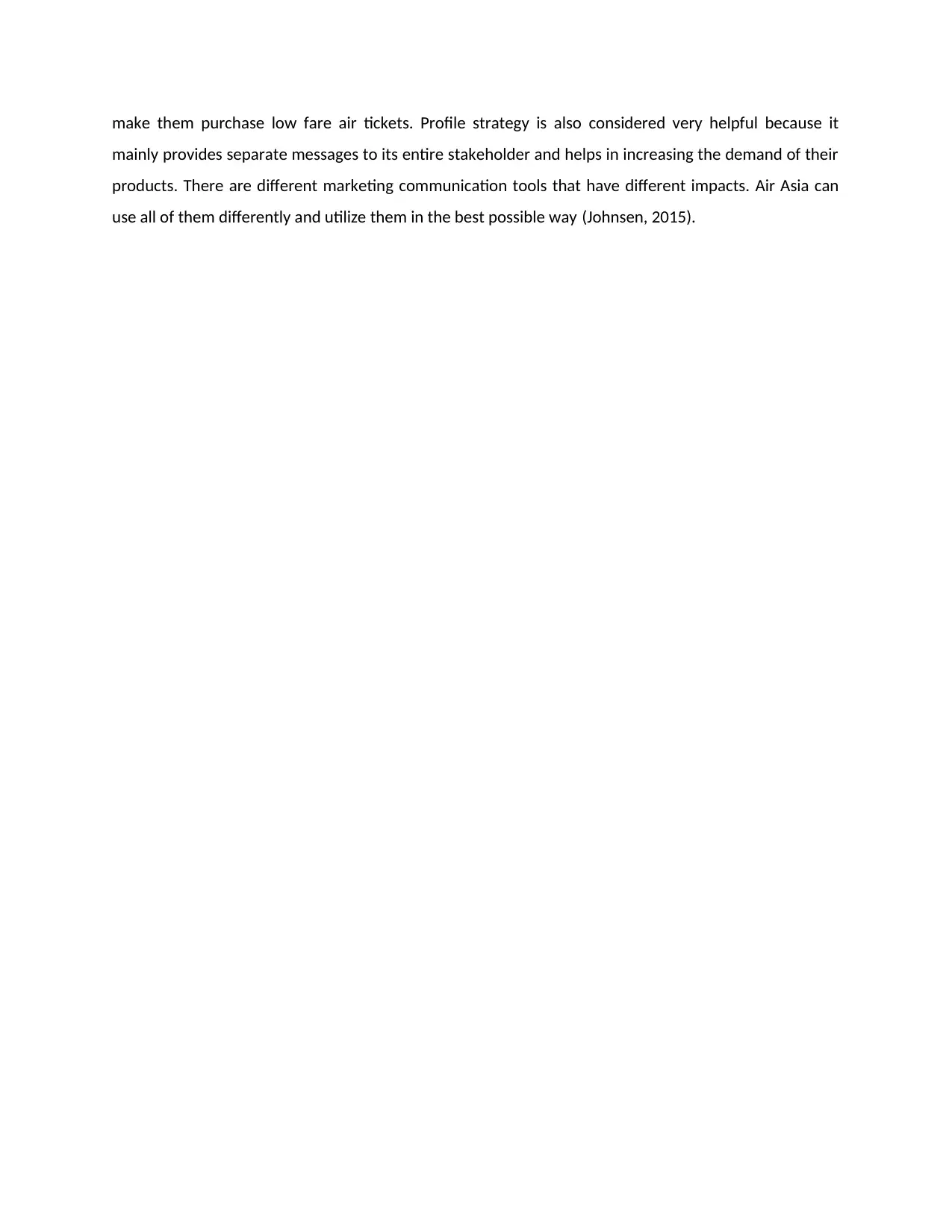
make them purchase low fare air tickets. Profile strategy is also considered very helpful because it
mainly provides separate messages to its entire stakeholder and helps in increasing the demand of their
products. There are different marketing communication tools that have different impacts. Air Asia can
use all of them differently and utilize them in the best possible way (Johnsen, 2015).
mainly provides separate messages to its entire stakeholder and helps in increasing the demand of their
products. There are different marketing communication tools that have different impacts. Air Asia can
use all of them differently and utilize them in the best possible way (Johnsen, 2015).
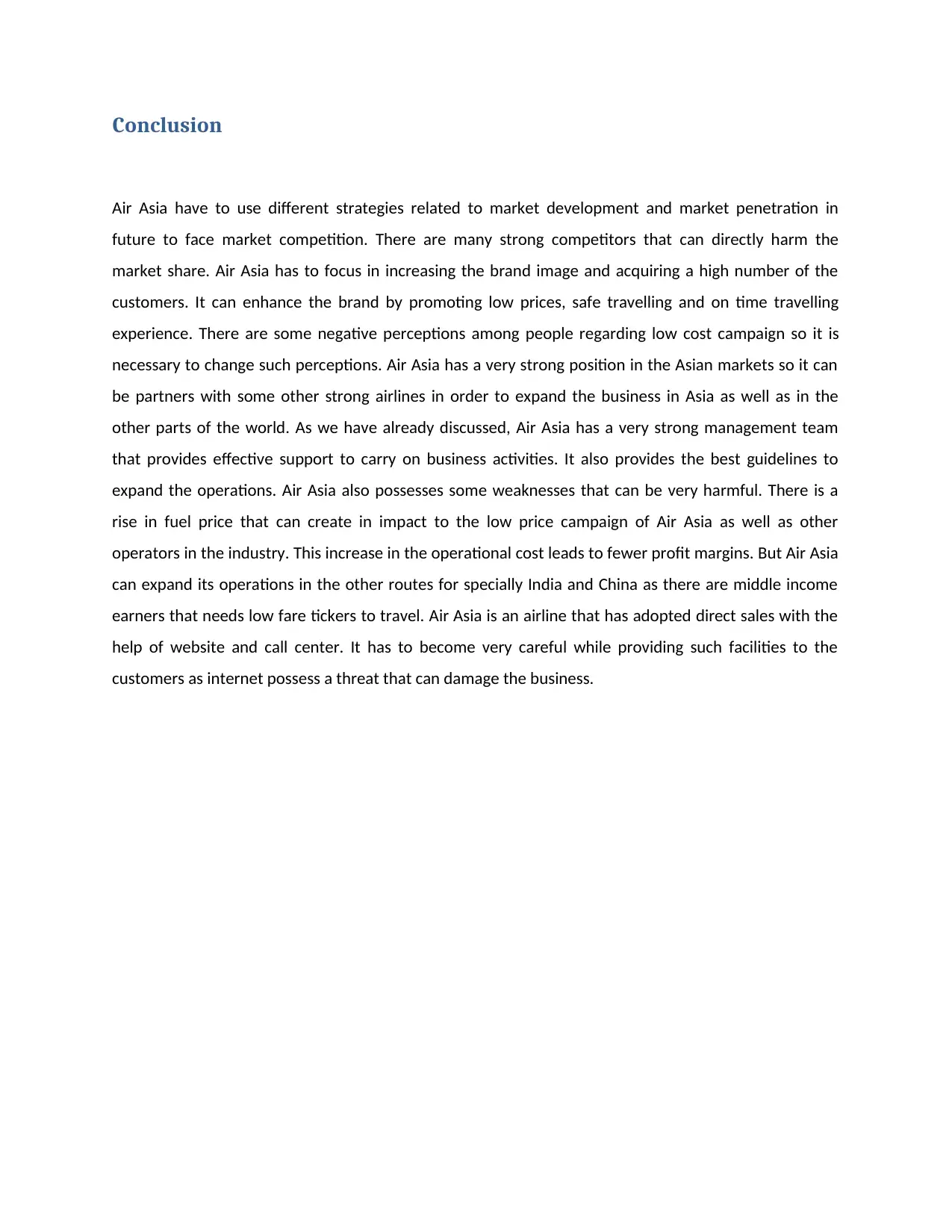
Conclusion
Air Asia have to use different strategies related to market development and market penetration in
future to face market competition. There are many strong competitors that can directly harm the
market share. Air Asia has to focus in increasing the brand image and acquiring a high number of the
customers. It can enhance the brand by promoting low prices, safe travelling and on time travelling
experience. There are some negative perceptions among people regarding low cost campaign so it is
necessary to change such perceptions. Air Asia has a very strong position in the Asian markets so it can
be partners with some other strong airlines in order to expand the business in Asia as well as in the
other parts of the world. As we have already discussed, Air Asia has a very strong management team
that provides effective support to carry on business activities. It also provides the best guidelines to
expand the operations. Air Asia also possesses some weaknesses that can be very harmful. There is a
rise in fuel price that can create in impact to the low price campaign of Air Asia as well as other
operators in the industry. This increase in the operational cost leads to fewer profit margins. But Air Asia
can expand its operations in the other routes for specially India and China as there are middle income
earners that needs low fare tickers to travel. Air Asia is an airline that has adopted direct sales with the
help of website and call center. It has to become very careful while providing such facilities to the
customers as internet possess a threat that can damage the business.
Air Asia have to use different strategies related to market development and market penetration in
future to face market competition. There are many strong competitors that can directly harm the
market share. Air Asia has to focus in increasing the brand image and acquiring a high number of the
customers. It can enhance the brand by promoting low prices, safe travelling and on time travelling
experience. There are some negative perceptions among people regarding low cost campaign so it is
necessary to change such perceptions. Air Asia has a very strong position in the Asian markets so it can
be partners with some other strong airlines in order to expand the business in Asia as well as in the
other parts of the world. As we have already discussed, Air Asia has a very strong management team
that provides effective support to carry on business activities. It also provides the best guidelines to
expand the operations. Air Asia also possesses some weaknesses that can be very harmful. There is a
rise in fuel price that can create in impact to the low price campaign of Air Asia as well as other
operators in the industry. This increase in the operational cost leads to fewer profit margins. But Air Asia
can expand its operations in the other routes for specially India and China as there are middle income
earners that needs low fare tickers to travel. Air Asia is an airline that has adopted direct sales with the
help of website and call center. It has to become very careful while providing such facilities to the
customers as internet possess a threat that can damage the business.
Paraphrase This Document
Need a fresh take? Get an instant paraphrase of this document with our AI Paraphraser
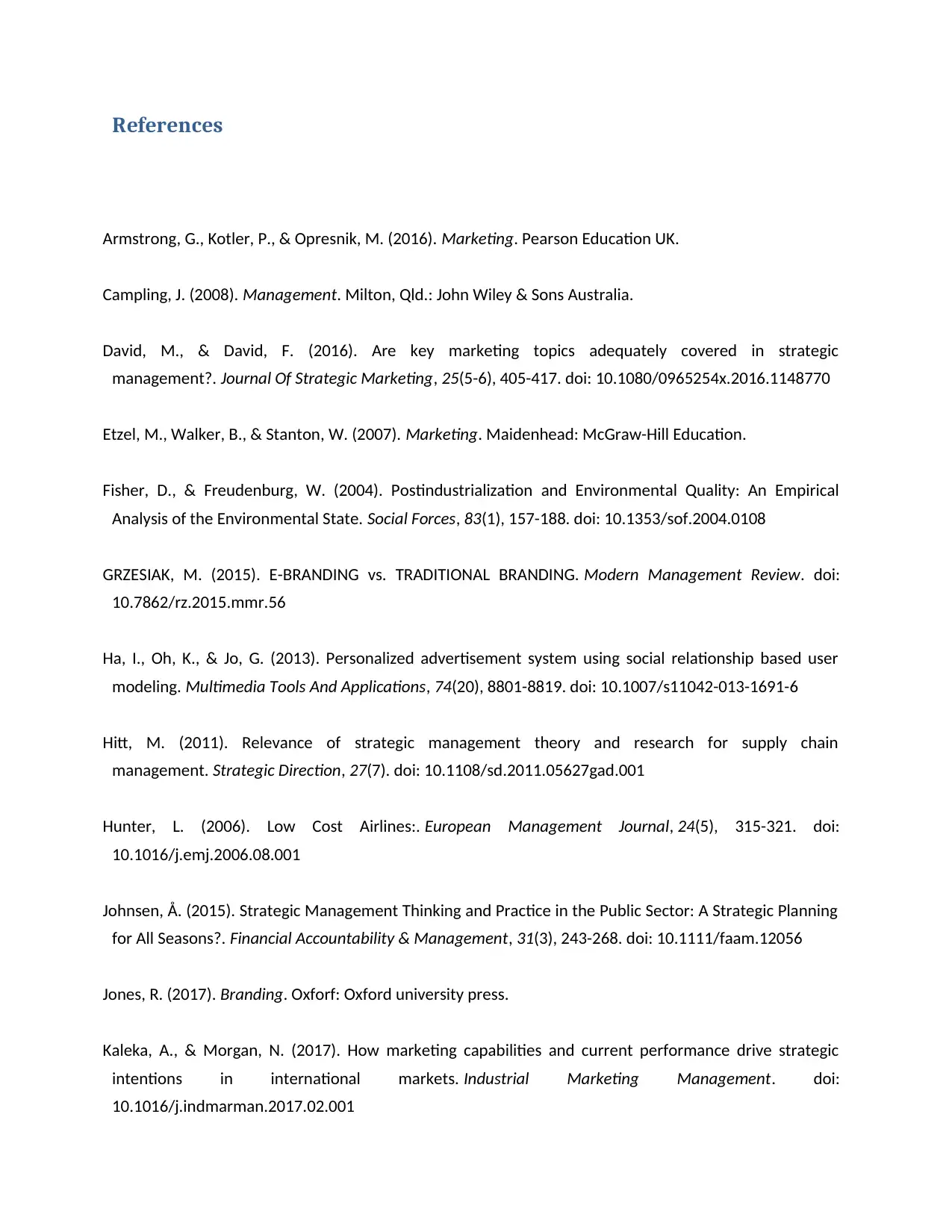
References
Armstrong, G., Kotler, P., & Opresnik, M. (2016). Marketing. Pearson Education UK.
Campling, J. (2008). Management. Milton, Qld.: John Wiley & Sons Australia.
David, M., & David, F. (2016). Are key marketing topics adequately covered in strategic
management?. Journal Of Strategic Marketing, 25(5-6), 405-417. doi: 10.1080/0965254x.2016.1148770
Etzel, M., Walker, B., & Stanton, W. (2007). Marketing. Maidenhead: McGraw-Hill Education.
Fisher, D., & Freudenburg, W. (2004). Postindustrialization and Environmental Quality: An Empirical
Analysis of the Environmental State. Social Forces, 83(1), 157-188. doi: 10.1353/sof.2004.0108
GRZESIAK, M. (2015). E-BRANDING vs. TRADITIONAL BRANDING. Modern Management Review. doi:
10.7862/rz.2015.mmr.56
Ha, I., Oh, K., & Jo, G. (2013). Personalized advertisement system using social relationship based user
modeling. Multimedia Tools And Applications, 74(20), 8801-8819. doi: 10.1007/s11042-013-1691-6
Hitt, M. (2011). Relevance of strategic management theory and research for supply chain
management. Strategic Direction, 27(7). doi: 10.1108/sd.2011.05627gad.001
Hunter, L. (2006). Low Cost Airlines:. European Management Journal, 24(5), 315-321. doi:
10.1016/j.emj.2006.08.001
Johnsen, Å. (2015). Strategic Management Thinking and Practice in the Public Sector: A Strategic Planning
for All Seasons?. Financial Accountability & Management, 31(3), 243-268. doi: 10.1111/faam.12056
Jones, R. (2017). Branding. Oxforf: Oxford university press.
Kaleka, A., & Morgan, N. (2017). How marketing capabilities and current performance drive strategic
intentions in international markets. Industrial Marketing Management. doi:
10.1016/j.indmarman.2017.02.001
Armstrong, G., Kotler, P., & Opresnik, M. (2016). Marketing. Pearson Education UK.
Campling, J. (2008). Management. Milton, Qld.: John Wiley & Sons Australia.
David, M., & David, F. (2016). Are key marketing topics adequately covered in strategic
management?. Journal Of Strategic Marketing, 25(5-6), 405-417. doi: 10.1080/0965254x.2016.1148770
Etzel, M., Walker, B., & Stanton, W. (2007). Marketing. Maidenhead: McGraw-Hill Education.
Fisher, D., & Freudenburg, W. (2004). Postindustrialization and Environmental Quality: An Empirical
Analysis of the Environmental State. Social Forces, 83(1), 157-188. doi: 10.1353/sof.2004.0108
GRZESIAK, M. (2015). E-BRANDING vs. TRADITIONAL BRANDING. Modern Management Review. doi:
10.7862/rz.2015.mmr.56
Ha, I., Oh, K., & Jo, G. (2013). Personalized advertisement system using social relationship based user
modeling. Multimedia Tools And Applications, 74(20), 8801-8819. doi: 10.1007/s11042-013-1691-6
Hitt, M. (2011). Relevance of strategic management theory and research for supply chain
management. Strategic Direction, 27(7). doi: 10.1108/sd.2011.05627gad.001
Hunter, L. (2006). Low Cost Airlines:. European Management Journal, 24(5), 315-321. doi:
10.1016/j.emj.2006.08.001
Johnsen, Å. (2015). Strategic Management Thinking and Practice in the Public Sector: A Strategic Planning
for All Seasons?. Financial Accountability & Management, 31(3), 243-268. doi: 10.1111/faam.12056
Jones, R. (2017). Branding. Oxforf: Oxford university press.
Kaleka, A., & Morgan, N. (2017). How marketing capabilities and current performance drive strategic
intentions in international markets. Industrial Marketing Management. doi:
10.1016/j.indmarman.2017.02.001
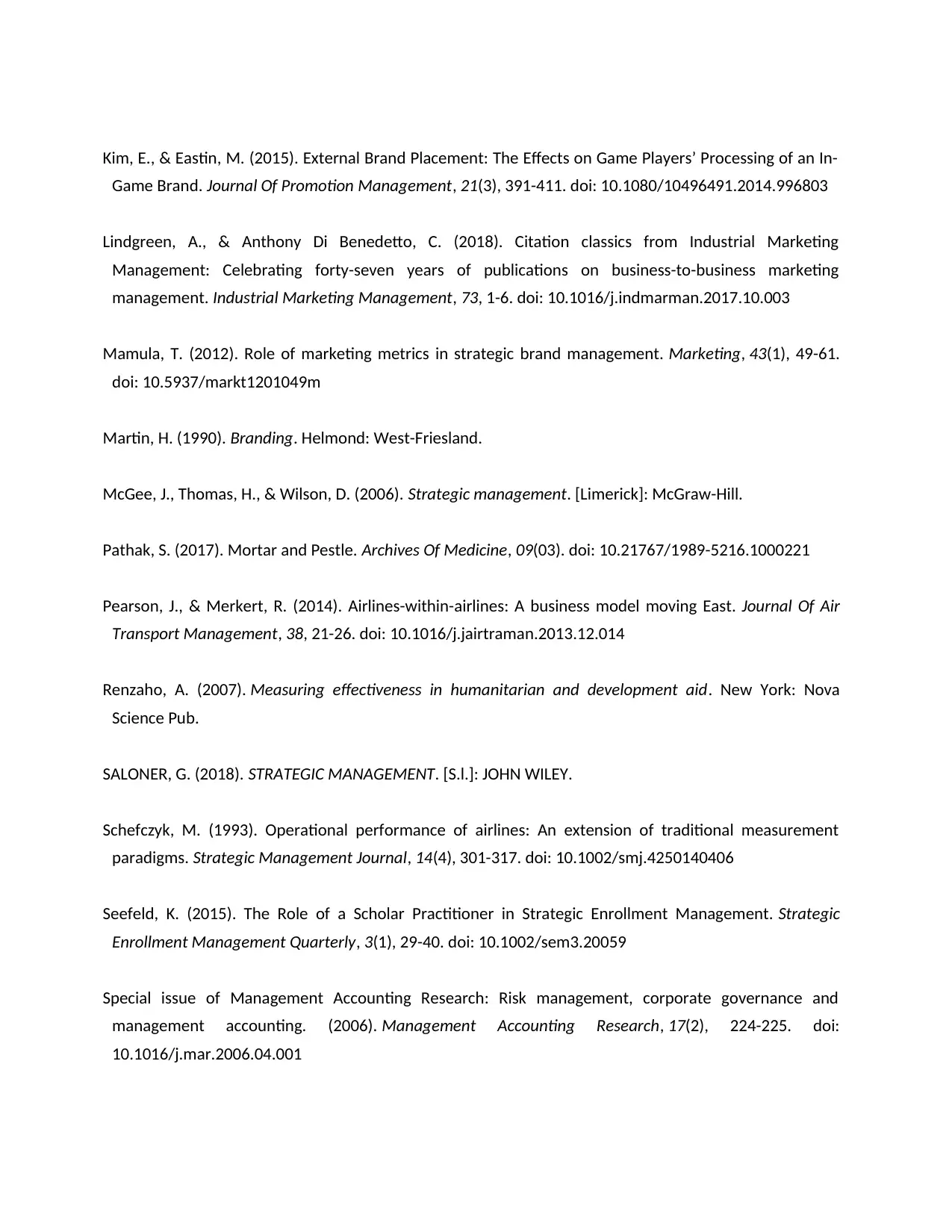
Kim, E., & Eastin, M. (2015). External Brand Placement: The Effects on Game Players’ Processing of an In-
Game Brand. Journal Of Promotion Management, 21(3), 391-411. doi: 10.1080/10496491.2014.996803
Lindgreen, A., & Anthony Di Benedetto, C. (2018). Citation classics from Industrial Marketing
Management: Celebrating forty-seven years of publications on business-to-business marketing
management. Industrial Marketing Management, 73, 1-6. doi: 10.1016/j.indmarman.2017.10.003
Mamula, T. (2012). Role of marketing metrics in strategic brand management. Marketing, 43(1), 49-61.
doi: 10.5937/markt1201049m
Martin, H. (1990). Branding. Helmond: West-Friesland.
McGee, J., Thomas, H., & Wilson, D. (2006). Strategic management. [Limerick]: McGraw-Hill.
Pathak, S. (2017). Mortar and Pestle. Archives Of Medicine, 09(03). doi: 10.21767/1989-5216.1000221
Pearson, J., & Merkert, R. (2014). Airlines-within-airlines: A business model moving East. Journal Of Air
Transport Management, 38, 21-26. doi: 10.1016/j.jairtraman.2013.12.014
Renzaho, A. (2007). Measuring effectiveness in humanitarian and development aid. New York: Nova
Science Pub.
SALONER, G. (2018). STRATEGIC MANAGEMENT. [S.l.]: JOHN WILEY.
Schefczyk, M. (1993). Operational performance of airlines: An extension of traditional measurement
paradigms. Strategic Management Journal, 14(4), 301-317. doi: 10.1002/smj.4250140406
Seefeld, K. (2015). The Role of a Scholar Practitioner in Strategic Enrollment Management. Strategic
Enrollment Management Quarterly, 3(1), 29-40. doi: 10.1002/sem3.20059
Special issue of Management Accounting Research: Risk management, corporate governance and
management accounting. (2006). Management Accounting Research, 17(2), 224-225. doi:
10.1016/j.mar.2006.04.001
Game Brand. Journal Of Promotion Management, 21(3), 391-411. doi: 10.1080/10496491.2014.996803
Lindgreen, A., & Anthony Di Benedetto, C. (2018). Citation classics from Industrial Marketing
Management: Celebrating forty-seven years of publications on business-to-business marketing
management. Industrial Marketing Management, 73, 1-6. doi: 10.1016/j.indmarman.2017.10.003
Mamula, T. (2012). Role of marketing metrics in strategic brand management. Marketing, 43(1), 49-61.
doi: 10.5937/markt1201049m
Martin, H. (1990). Branding. Helmond: West-Friesland.
McGee, J., Thomas, H., & Wilson, D. (2006). Strategic management. [Limerick]: McGraw-Hill.
Pathak, S. (2017). Mortar and Pestle. Archives Of Medicine, 09(03). doi: 10.21767/1989-5216.1000221
Pearson, J., & Merkert, R. (2014). Airlines-within-airlines: A business model moving East. Journal Of Air
Transport Management, 38, 21-26. doi: 10.1016/j.jairtraman.2013.12.014
Renzaho, A. (2007). Measuring effectiveness in humanitarian and development aid. New York: Nova
Science Pub.
SALONER, G. (2018). STRATEGIC MANAGEMENT. [S.l.]: JOHN WILEY.
Schefczyk, M. (1993). Operational performance of airlines: An extension of traditional measurement
paradigms. Strategic Management Journal, 14(4), 301-317. doi: 10.1002/smj.4250140406
Seefeld, K. (2015). The Role of a Scholar Practitioner in Strategic Enrollment Management. Strategic
Enrollment Management Quarterly, 3(1), 29-40. doi: 10.1002/sem3.20059
Special issue of Management Accounting Research: Risk management, corporate governance and
management accounting. (2006). Management Accounting Research, 17(2), 224-225. doi:
10.1016/j.mar.2006.04.001
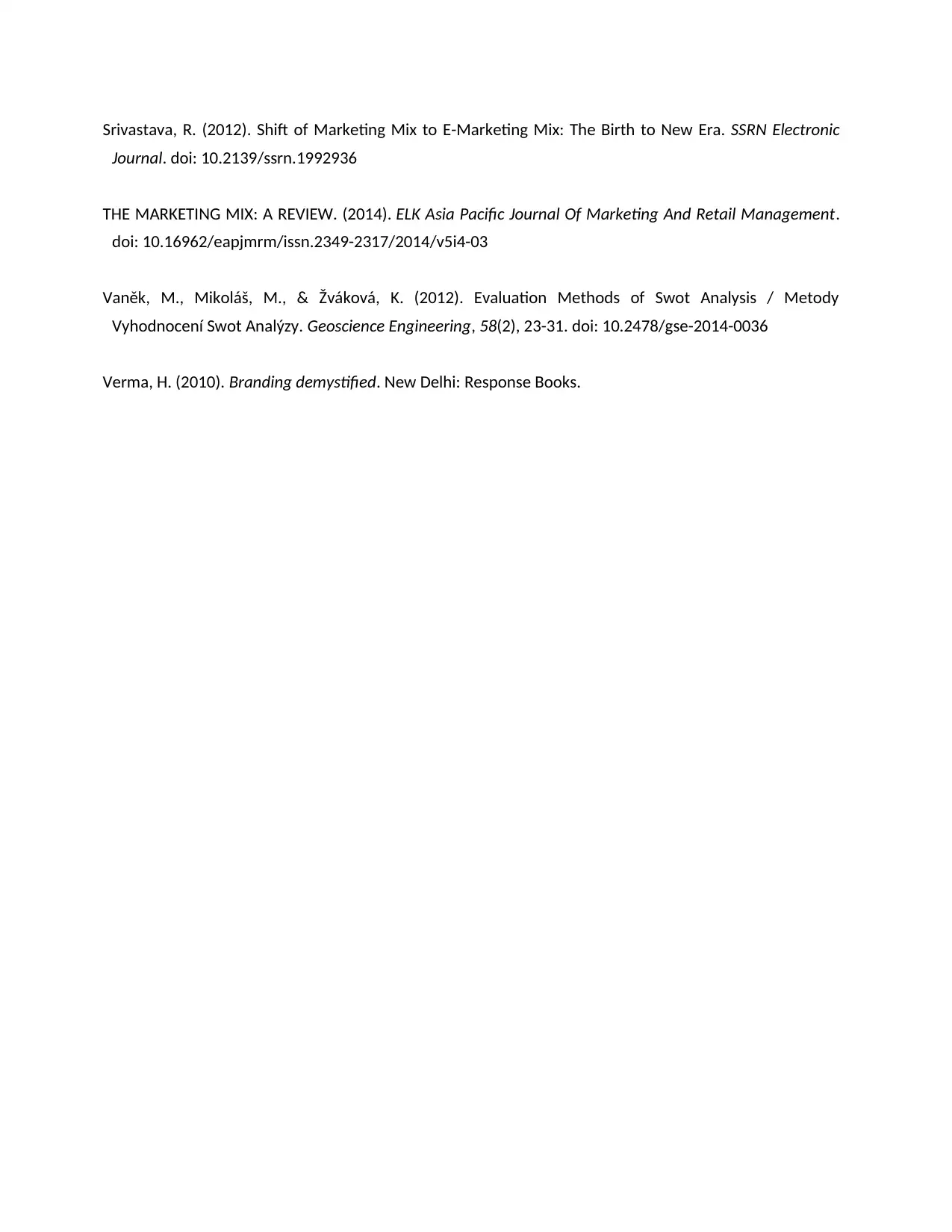
Srivastava, R. (2012). Shift of Marketing Mix to E-Marketing Mix: The Birth to New Era. SSRN Electronic
Journal. doi: 10.2139/ssrn.1992936
THE MARKETING MIX: A REVIEW. (2014). ELK Asia Pacific Journal Of Marketing And Retail Management.
doi: 10.16962/eapjmrm/issn.2349-2317/2014/v5i4-03
Vaněk, M., Mikoláš, M., & Žváková, K. (2012). Evaluation Methods of Swot Analysis / Metody
Vyhodnocení Swot Analýzy. Geoscience Engineering, 58(2), 23-31. doi: 10.2478/gse-2014-0036
Verma, H. (2010). Branding demystified. New Delhi: Response Books.
Journal. doi: 10.2139/ssrn.1992936
THE MARKETING MIX: A REVIEW. (2014). ELK Asia Pacific Journal Of Marketing And Retail Management.
doi: 10.16962/eapjmrm/issn.2349-2317/2014/v5i4-03
Vaněk, M., Mikoláš, M., & Žváková, K. (2012). Evaluation Methods of Swot Analysis / Metody
Vyhodnocení Swot Analýzy. Geoscience Engineering, 58(2), 23-31. doi: 10.2478/gse-2014-0036
Verma, H. (2010). Branding demystified. New Delhi: Response Books.
1 out of 19
Related Documents
Your All-in-One AI-Powered Toolkit for Academic Success.
+13062052269
info@desklib.com
Available 24*7 on WhatsApp / Email
![[object Object]](/_next/static/media/star-bottom.7253800d.svg)
Unlock your academic potential
© 2024 | Zucol Services PVT LTD | All rights reserved.





